Nowadays there is a fast-growing awareness amongst the architects and engineers to plan, design and construct the buildings, keeping the safety of the occupants as the focus in the event of outbreak of fire. Once the fire starts, it has a tendency to ignite all the combustible materials of the surrounding area and if not checked in time, it may spread to other parts of the buildings and ultimately lead to the collapse of the building. Most of the countries have described fire resistance in terms of duration of resistance to fire i.e. 1 hour, 2 hours of fire resistance etc. There are also norms and regulations that should be kept in mind by architects & engineers to design buildings.
It is always the fuel that causes and aggravates the fire. Duration and temperature of fire also decides the quantum of damage. Hence the materials used in construction of the building should be non-combustible and do not cause heavy smoke. It is not possible to attain absolute safety from fire but by adopting certain measures like usage of certain fire-resistant materials in building construction, it is definitely possible to provide reasonable degree of safety from fire.
According to ‘National Building Code of India’ (Part 4 Fire and Life Safety-2005) fire resistance is a property of either an element or material of building construction and is the measure of its ability to satisfy for a stated period of some or all of the following criteria:
(a) Resistance to collapse
(b) Resistance to penetration of flame and hot gases
(c) Resistance to temperature rise on the unexposed face up to a maximum of 180 degree Celsius and/or average temperature of 150 degree Celsius.
Building materials used in constructing a house can be of two types:
01. Non-combustible Materials
02. Combustible Materials
Non-Combustible Materials
These materials do not contribute to the growth of fire but may get damaged when the temperature is reached to a very high level where decomposition of fusion occurs, resulting in the loss of strength of the building. If such materials are used in the structure, it may maintain the integrity of structure for longer duration but may eventually collapse. Examples of such materials are metal, stone, glass, concrete, clay products, gypsum products and asbestos products.
Combustible Materials
Combustible materials will combine exothermically with oxygen, give rise to flame and spread the fire. Such materials whether form part of the structure or contents of the building, burn themselves and increase the intensity and growth of fire i.e. it acts as a fuel for the fire. Examples of such materials are wood and all wooden products, manufactured products such as fibre board, straw board, etc.
It can be said that non-combustible materials are safe up to certain level to use in building / house for the simple facts it cannot become the fuel for fire. According To ‘U. S. DEPARTMENT OF COMMERCE’ all structural members are required to be of non-combustible materials irrespective of the degree of fire resistance. So, here we have discussed few fire-resistant building materials that can be used in construction to minimize the fire related damages.
Fire-Resistant Materials
01. Stones
Stones are used in a hilly area where stones are available easily. Depending upon their characteristics, different types of stones are used at different places. Polished granites are used as table tops, cladding for walls and columns. Stones are also used in backyard garden for planters, in entrance hallway in home and to build compound wall. Granite, sandstone and limestone are used to build walls. Slate stones are used in roofs and floors.
Stone has a higher capacity to withstand fire up to 13000C – 15000C, beyond which it starts melting/breaking. The use of stone in a fire-resisting construction should be restricted to a minimum as this fire-resistant material cannot resist sudden cooling and breaks into pieces.
Granite, when subjected to excessive heat, crumbles to sand or cracks and turns into pieces with a series of explosions and disintegration. The use of limestone is not at all desirable as it gets crumbled and ruined (turns to quick lime) under the effects of fire. The compact sandstone has better resistance against fire than limestone as it can stand the exposure to moderate fire without serious cracks. It will depend upon the temperature at which such stones will give in.
02. Bricks

Bricks are the most common and favoured construction material throughout the world. Bricks are used for the construction of wall, lintel and arch, retaining wall, cavity wall and damp roof courses etc. Bricks are also used to give aesthetic appearance to the structure.
First class bricks are practically fireproof as they can withstand the exposure of fire for a considerable length of time. Being poor conductors of heat, the bricks can withstand high temperatures up to 13000C without causing serious effects. Fire bricks are best for use in fire-resisting construction. Fire bricks have melting point about 28000C. The degree of fire-resistance of bricks depends upon factors like size of bricks, composition of brick clay, method of construction, etc. Though brick has its own structural limitations for use in buildings but brick masonry has been proved to be most suitable for safeguarding the structure against the fire-hazards.
03. Steel
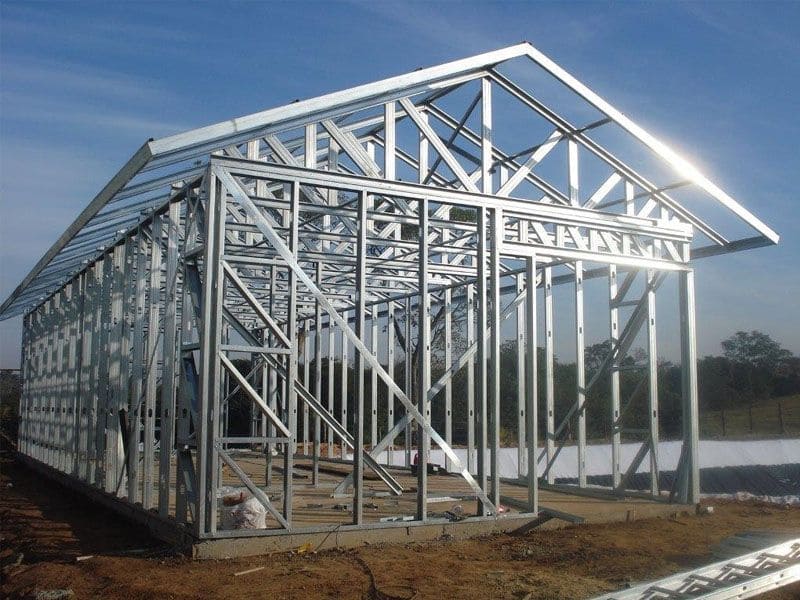
Steel is used to build high rise building, residential buildings. Steel is used in beam, column, lintel purlin, roof, ceiling, walls etc. It is also used in building as heating and cooling equipment and interior ducting. Steel is also used in Internal fixtures and fittings such as rails, stairs and shelving
Steel although is non-combustible fire-resistant material, it has a very low fire-resistance value. With increase in temperature, it gets softened and hence reduction in resistance to the effects of tension and compression. At about 6000C, its yield strength is reduced to only one-third of its value at normal temperatures. Steel melts at 14000C. When the structures made of steel come in contact with water used for extinguishing the fire, they tend to contract, twist or distort and thus the stability of the entire structure is endangered.
It has been observed in practice that unprotected steel beams sag and steel columns buckle, both resulting in collapse of building. It is, therefore, necessary in the fire-resisting characteristics of a structure, to protect all the structural steel members with some covering of fire insulation material. This can be achieved by covering the steel members completely with materials like bricks, burnt clay blocks, terra-cotta, concrete or breeze concrete, etc.
04. Wrought-Iron and Cast-Iron

Wrought iron is used as a decorative purpose in outdoor stairs, railing, gates and fences. Cast-Iron is used for making sanitary fittings i.e. manholes, water pipes and sewer pipes. It is also used to make metal columns and column bases.
Wrought-iron behaves almost like steel when subjected to fire except that it has lesser elasticity and cover strength in compression and tension as compared to steel. Cast-iron is rarely used for fire-resisting point of view in construction as on sudden cooling, it gets contracted and breaks into pieces or fragments. They melt at around 11000C to 15000C. For using cast iron in fire-resistive construction, it should also be protected by a suitable covering of bricks, concrete etc.
05. Aluminium

Aluminium is used for window frames, for roofing, and curtain walling, as well as for cast door handles, catches for windows and staircases.
In some advanced countries, the aluminium is being used for reinforcement purposes in multi-storied structures because of its light weight and anti-corrosion properties. Melting point of aluminium is about 6600C. However, it can give very poor performance as a fire-resistant material and its use (as alloy) should be restricted to those structures which have low fire risks or more making hangers. It is good conductor of heat and possesses enough tensile strength.
06. Concrete
In general, it is a bad conductor of heat and is a good fire-resistant material. Concrete does not have melting point but there is loss of strength after certain degree of temperature. There is no loss of strength in concrete up to 2500C. The actual degree of fire-resistance of concrete depends upon the nature of aggregates used and its density. In case of RCC and pre-stressed construction, it depends upon the position of steel in concrete. RCC structure can resist fire up to 10000C for one hour. From the studies, it is found that ordinary concrete, when exposed to fire, gets dehydrated and results in shrinkage cracks (This happens, because on heating, aggregates in concrete expand whereas cement shrinks and these two opposite actions lead to de-bonding of both materials & develop cracks.)
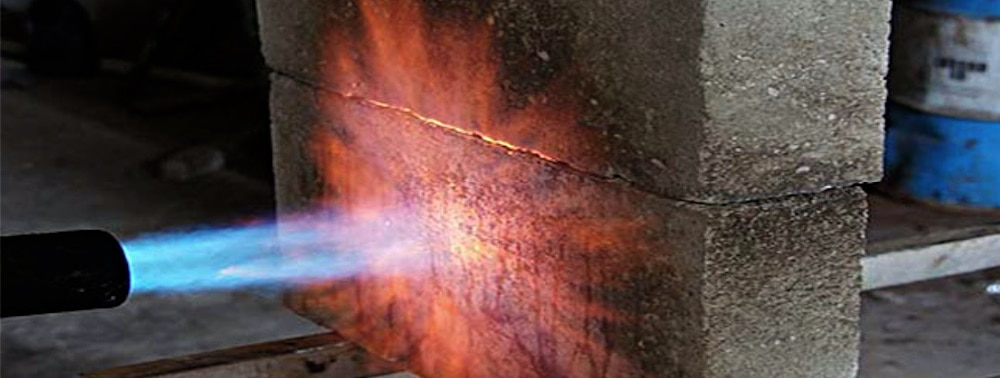
Coarse aggregates, like foamed slag, blast furnace slag, crushed brick, crushed limestone, cinder etc. are best suited for concrete from viewpoint of fire resistance. Aggregates like flint, gravel, granite etc. possess poor fire-resisting characteristics. It has been observed in the event of average fire that the concrete surface gets disintegrated for a depth of about 25 mm because of the fact that the mortar in concrete gets dehydrated by the fire. Hence, in case of reinforced concrete fire resistive construction, the cover of sufficient thickness should be provided (cracks generally originate from the reinforcement). R.C.C. structures are considered superior to steel framed structures as less steel is used and that too well protected by the mass concrete. According to ‘V.K.R. Kodur’ (2003, Senior Research Officer, Institute for Research in Construction, Canada ), in reinforced and prestressed concrete structural members, the required fire resistance is generally obtained by the provision of minimum member dimensions and minimum thickness of concrete cover.
07. Glass
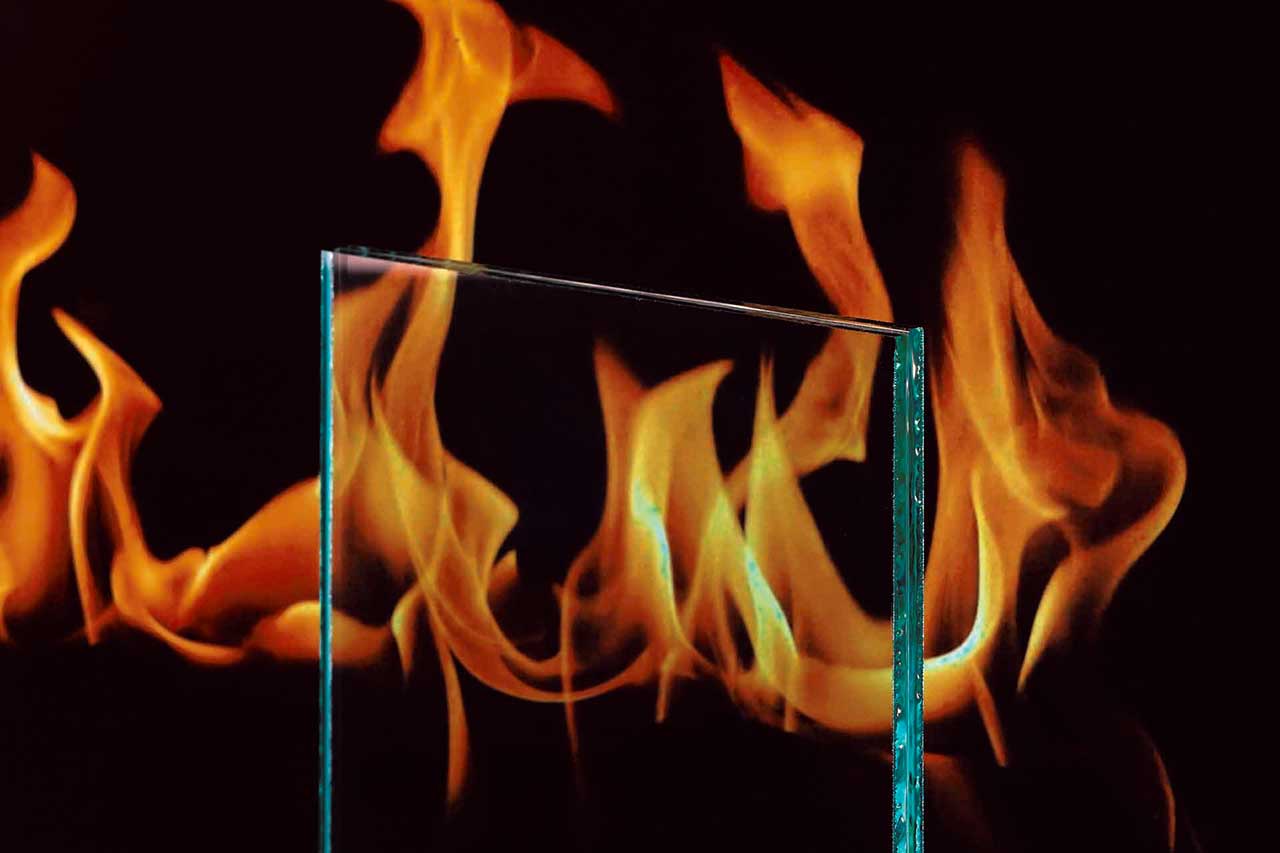
Because of its low thermal conductivity, glass is a very good fire-resistant material. It undergoes negligible change in volume during expansion or contraction and hence considered to be a good fire-resistant material Glass melts at approximately around 14000C to 16000C. Sudden and extreme changes in temperature, however, result in fracture or cracks. But when glass is reinforced with steel wire netting, e.g., in wired glass, its fire resistance is considerably increased, and its tendency to fracture with sudden changes in temperature, gets minimized. Reinforced glass has a higher melting point and hence commonly used for making fire-resisting doors, skylight, windows etc. in construction work. Glass Ceramic can handle very high temperature and are suitable for fire-proof doors.
08. Asbestos Cement

This fire-resistant material, which is formed by combining fibrous mineral with Portland cement, has a great fire-resistive value. Its melting point is about 8710C. Asbestos cement products are widely used for the construction of fire-resistive partitions and roofs among others. Being poor conductor of heat and incombustible material, the structural members blended with asbestos cement offer great resistance to cracking, swelling, or disintegration when subjected to fire.
09. Plaster or Mortar
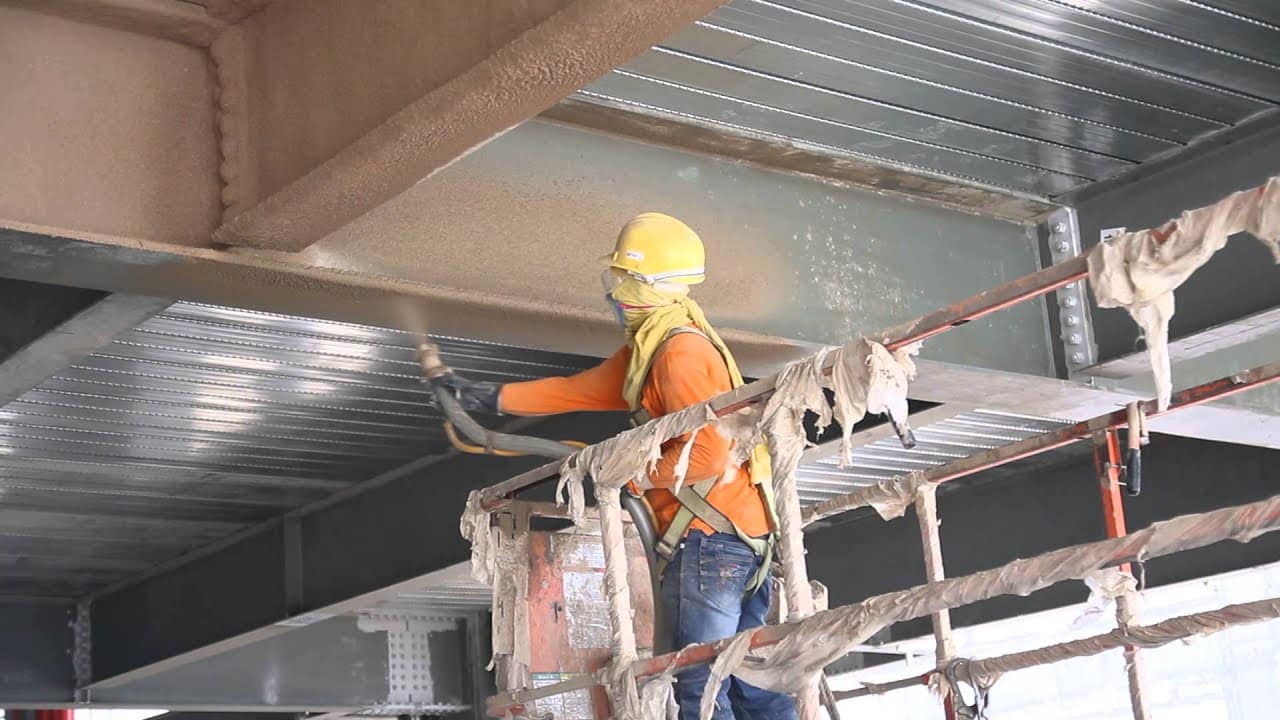
It is an incombustible fire-resistant material and hence used for protecting the walls and ceilings of building from fire-risks. Cement plaster is better than lime plaster as the latter is likely to be calcined. The fire resistance of the plaster to fire hazards can be increased by using it in thicker layer or reinforcing the plaster with metal lathes. Gypsum plaster is also applied on steel columns and other steel members to increase their fire-resistive qualities. The use of fire-resistant materials like cement mortar with surkhi or pozzolana is preferred from the viewpoint of fire-resistance. Nowadays vermiculite plaster is also used as fire-resistant material. Vermiculite is used in building boards because of its low density and good insulation properties.
10. Gypsum
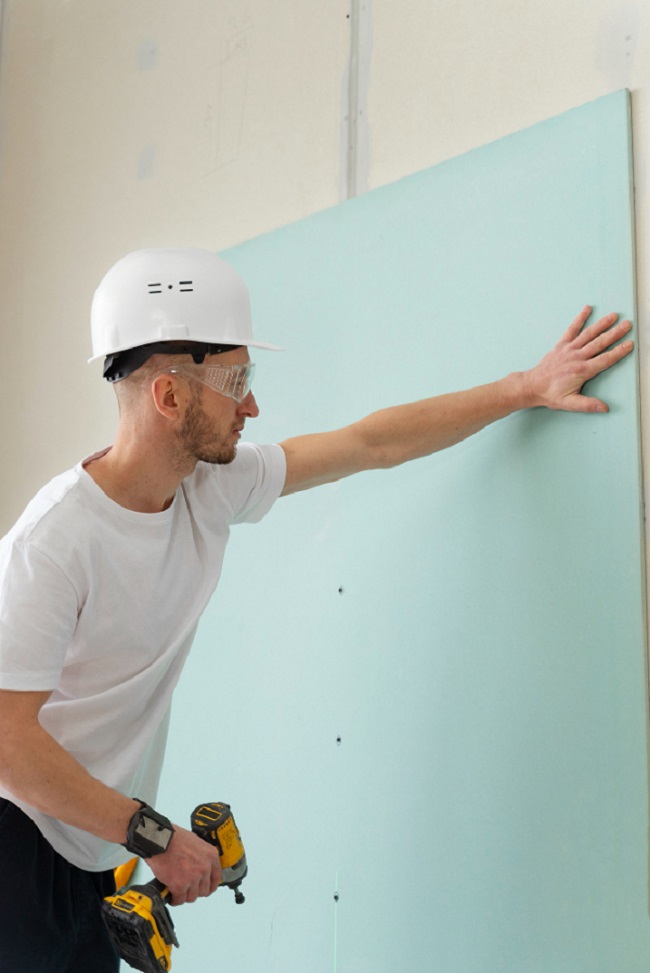
Gypsum is another commonly used fire-resistant material used in construction world. Gypsum has melting point about 1000C – 1500C. Many structural materials are attached underneath with gypsum sheeting to prevent any fire hazards and to achieve good fire-resistant ratings.
Gypsum boards, also known as “dry-walls” are chemically treated to increase the firefighting abilities of gypsum. Builders use multiple layers of gypsum coating on gypsum boards to make sure that the fire resistance properties of the underlying physical structure get enhanced.
11. Terra-Cotta
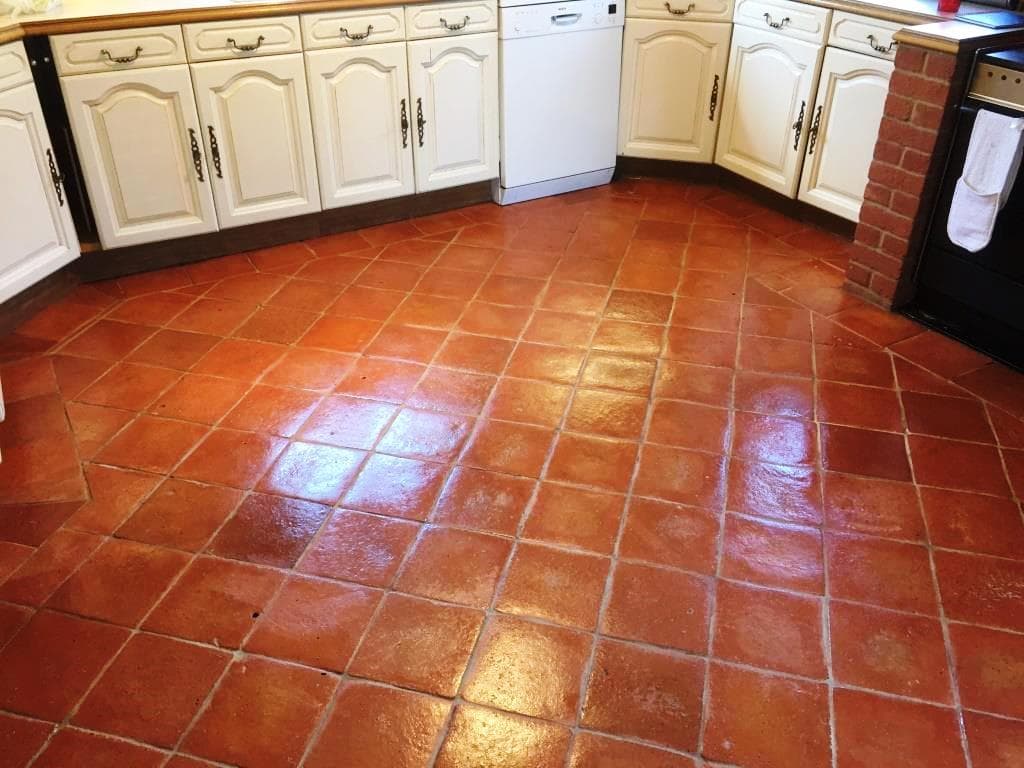
It is also a clay product like brick but possesses better fire-resisting qualities than bricks. Being costlier, its use is restricted in the construction of fire-resisting floors only.
12. Stucco

Stucco is a plaster that has been used for centuries for both structural purposes and artistic. Modern stucco is made of Portland cement, sand and lime, and it serves as an excellent and durable fire-resistant material for buildings. It can cover any structural material, such as wood or brick. It generally consists of two or three coats over metal reinforcing mesh. one-inch (2.54-centimeter) layer of stucco can easily lend a 1-hour fire rating to a wall. Roof eaves (overhangs) are fire hazardous, but they can be protected with an encasement of fire-resistant material. Stucco is often suggested as one of the best materials for boxing in hazardous eaves. Because of versality in finishing techniques, stucco can come in various textures and colours.
After discussing all the above building materials, it can be said that proper selection of the fire-resistant material and the method of construction plays a very important role in minimizing danger of fire. In a fire-resistant construction, the maximum use of non-combustible materials should be encouraged. Depending upon availability of fire-resistant material and the budget you can choose appropriate materials for your house construction. However, you have to choose the material judiciously comparing its behaviour with other loads like earthquake, cyclone, rain, wind and so on. We hope that the above discussion will guide you effectively in selecting proper materials for your house.
Must Read:
8 Eco Friendly Building Materials Utilised in Green/Sustainable Buildings!
Types of Materials that Can be Used in Masonry and its Specifications!
Image Courtesy: Image 3, Image 4, Image 5 – Nextdoorsystem, Image 6 – Universal-concrete, Image 7, Image 9








